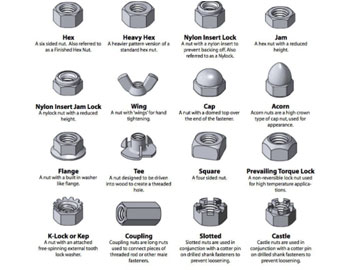A nut is a type of fastener with a threaded hole. Nuts are almost always used in conjunction with a mating bolt to fasten multiple parts together. A wide variety of nuts exists, from household hardware versions to specialized industry-specific designs that are engineered to meet various technical standards.
Nuts
Prevailing Torque Lock Nuts (Stover)
Commonly known as stover nuts, prevailing torque lock nuts have chamfered corners and a conical top. The distortion in the top thread’s resists loosening from vibration. Also called one-way nuts, they can only be installed one way and are often used in high temperature application because they are all metal with no nylon insert.





















